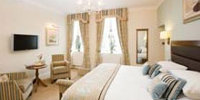Myths and Legends of Eden
The myths and legends of Eden have been handed down from generation to generation, for hundreds of years. Eden has Tales of legendary giants and valiant knights. Norse gods and Arthurian mythology, blend with more recent stories of ghosts and Victori an invention.
an invention.
Giants Grave, Penrith
In the graveyard of St Andrews Church in Penrith is the 'Giants Grave', where it is believed that Owen Cæsarius - king of Cumbria between 900 and 937 AD - is buried. The 'Giants Grave' is a collection of ancient grave stones comprising two 11' high stone crosses and four hog-back stones. An excavation of the 'Giants Grave' showed a skeleton underneath with a sword. The four hog-back stones surrounding the grave are said to represent the four wild boars he killed in Inglewood Forest.
Emma and Sir Eglamore of Aira Force
In medieval times a girl called Emma lived near Aira Force. She was betrothed to a renowned knight called Sir Eglamore. He had to leave her to follow the Crusades and Emma became so disturbed that she started sleep walking to Aira Force. Sir Eglamore returned unexpectedly from his travels, and found Emma at the top of the force where she tumbled into the depths. He was so distraught at losing his love that he became a hermit and lived in a cave above the force for the rest of his life. He built a little bridge across the raging beck so that no one else should topple over in the same way.
Lowther Castle, near Penrith

Lowther Castle was once the ancestral home of the wealthy Lord Lonsdale, and was once a palace much visited by royalty. Queen Victoria is reputed to have visited Lowther Castle and said that she would not return to Lowther Castle as it was too grand for her. One of the early Lords Lonsdale, better known as ‘Wicked Jimmy’ was one of the most famous ghosts, locally known as ‘boggles’ of Cumbria.
Haweswater and the Kings of Mardale

Haweswater is a reservoir built in the valley of Mardale in the 1930’s to provide water for Manchester. In creating the reservoir, the ancient settlement of Mardale was flooded - church, school, farms and the famous Dun Bell Inn where the Mardale shepherds met - all went under the water. The Kings of Mardale were a family by the name of Holme who were descended from Hugh Holme who fled to Mardale in 1208 after being involved in a conspiracy against the King. In very dry summers the ruins of Mardale can be seen again with the village’s stone walls appearing from the water.
The White Monks of Shap Abbey

Premonstratensian Canons founded Shap Abbey in the late twelfth century. The Canons were known locally as the ‘White Monks’ because of all their white clothing. Shap Abbey was the last Abbey to be founded in England with the monks setting up temporary wooden buildings next to the River Lowther as they built their church and living quarters.
The monks held great power over both this life and the afterlife. In 1560 after a theft from a house belonging to the Abbey some of the villagers were terrified when they were excommunicated from the church forever.
From the abbey, a short path leads over fields to the small 16th century Keld Chapel, now in the care of the National Trust.
The Orton Dobbie
‘Dobbie’ is a local word for a mischievous spirit. In the nineteenth century, at a house in Orton, a child’s cradle was overturned and furniture was seen to move around the floor. The Orton Dobbie inspired a great deal of interest, with experts from all over the country trying to solve the mystery. It was believed the Dobbie was the ghost of a man murdered on his way home from Kendal. The mystery was never solved. Some believe a local maid made the story up whilst others believed that the Dobbie was real.
The witches of Tebay
The most famous witch in Eden was Mary Baines or Baynes a local farmer's daughter born near Tebay and known as ‘the witch of Tebay.’ She was described as a ‘repulsive looking woman with a big pocket tied on her back.’ It was believed Mary had magicial powers and if anything strange happened it was believed to be her fault. Perhaps this is why the village is full of ‘witch stones’ - pieces of limestone, shaped and holed, which were set on top of garden walls to protect homes.
Ravenstonedale
This is a special place for religious historians as beside the church are foundations of an abbey. The Abbey was built by the Gilbertines - one of the early English orders of monks. Many early Quakers, who suffered severe punishment in local gaols came from this valley. The last female martyr for the Protestant faith who was burnt at the stake in London came from Brownber. The actual church is also special due to its strange arrangement of pews and the three tier pulpit, with the top most seat for the Parson’s wife.
The Last Wild Boar
Wild Boar Fell in Mallerstang, near Kirkby Stephen is said to be the place where the last wild boar in England is said to be killed by Sir Richard de Musgrave of Harcla Castle. His tomb surmounted by his effigy can be seen in Kirkby Stephen Church. Many years ago the tomb was opened and along with bones of a man and a woman were two wild boar tusks.
The Pagan God Loki
The Loki Stone - of which there are only 2 examples in Europe - can be found in Kirkby Stephen Parish Church. Loki was a Norse God and it is believed Viking settlers brought the belief in Loki to Kirkby Stephen. The Loki stone carving, shows a figure resembling the devil with sheep’s horns, with its arms and legs bound by heavy irons. The stone lay undiscovered for many years and is now one of the town’s most prized and famous possessions.
Stenkrith - The Devil’s Mustard Mill, Kirkby Stephen
Stenkrith Park is where the River Eden drops into a gorge known as Coopkarnel/Coop Kernan Hole (or the Devil's Mustard Pot/Mill). The deep gorge carved by the River Eden and the strange circular holes, hollowed out by pebbles have been swirled around by the River for centuries. Stories have long been told of how Stenkrith catered for the Devil’s hot taste and served as his mustard mill!
Pendragon Castle
According to legend Pendragon Castle was built by Uther Pendragon, the father of King Arthur. Uther is supposed to have tried diverting the water of the nearby River Eden to form a moat. However, not even the magic of Merlin could persuade the river to change its course. It is said Uther died at Pendragon Castle, after the Saxons, his enemies poisoned the well. The later Norman castle is thought to have been built by Sir Hugh de Morville, one of the knights who murdered Thomas a Becket in Canterbury Cathedral. Lammerside Castle, which is nearby also has links to Arthurian mythology and is supposed to be the legendary Castle Dolorous, home of the giant Sir Tarquin - who ate small boys!
supposed to have tried diverting the water of the nearby River Eden to form a moat. However, not even the magic of Merlin could persuade the river to change its course. It is said Uther died at Pendragon Castle, after the Saxons, his enemies poisoned the well. The later Norman castle is thought to have been built by Sir Hugh de Morville, one of the knights who murdered Thomas a Becket in Canterbury Cathedral. Lammerside Castle, which is nearby also has links to Arthurian mythology and is supposed to be the legendary Castle Dolorous, home of the giant Sir Tarquin - who ate small boys!
The Valiant Knight of Brough
Brough Castle is built on the site of a Roman fort which guarded the Stainmore Pass. It was the site of many battles from Scottish raiders who laid siege to the castle. The legendary bravery of one knight who defended the tower alone after his comrades had fallen is told in an ancient ballad. He was finally defeated when the tower was set on fire by the Scottish army. However the dramatic incident is remembered in the ballad of the Valiant Knight of Brough.
battles from Scottish raiders who laid siege to the castle. The legendary bravery of one knight who defended the tower alone after his comrades had fallen is told in an ancient ballad. He was finally defeated when the tower was set on fire by the Scottish army. However the dramatic incident is remembered in the ballad of the Valiant Knight of Brough.
The lost village of Burton
In Warcop Churchyard is a medieval archway - almost the only piece of the old village of Burton to have survived. The archway was removed from Burton Hall, before the army demolished it. Burton village and its farmsteads were taken over and used by the army during the Second World War to be used as a firing range. The villages of Warcop and Great Musgrave are also special as they both still hold traditional rush bearing ceremonies each year. Rush bearing dates back hundreds of years to when churches had earth floors and fresh rushes were gathered and strewn over the church floor each year.
Appleb y Castle
y Castle
The castle was founded at the beginning of the 12th century. In 1269 it came into the possession of Roger de Clifford and remained in the Clifford family for nearly 400 years. In the mid-17th century, Lady Anne Clifford lived at the castle and began its restoration, also building the nearby almshouses for deserving widows. The ghost of Lady Anne is said to wander Appleby Castle and she is buried in St Lawrence’s Church in Appleby.
Lacy’s Caves, near Little Salkeld

These impressive caves - a series of five chambers - are on the banks of the River Eden and carved out of the red sandstone. It seems Lacy’s Caves were carved in the 18th Century probably by Colonel Lacy’s workmen from nearby Salkeld Hall. The reason for their creation is unknown, however Colonel Lacy used them for entertaining guests and the area was originally planted with ornamental gardens.
Long Meg and her daughters
The 68 or so stones that make up Long Meg make her one of the largest prehistoric stone circles in the country. The most famous of the many legends that surround the stones is that they were once a coven of witches who were turned to stone by a wizard from Scotland. It is said the stones cannot be counted - but, if anyone is able to count them twice and come to the same total - the spell will be broken or it will bring very bad luck.
the country. The most famous of the many legends that surround the stones is that they were once a coven of witches who were turned to stone by a wizard from Scotland. It is said the stones cannot be counted - but, if anyone is able to count them twice and come to the same total - the spell will be broken or it will bring very bad luck.
Another legend states that if you walk round the circles and count the number on stones correctly, then put your ear to Long Meg, you will hear her whisper. The name itself is said to come from a local witch, Meg of Meldon, who was alive in the early 17th century.
The Croglin Vampire
The Croglin Vampire is one of the best known vampire stories in Britain. Several incidents took place between 1875 and 1876 in an old house in Croglin, which was being rented by a woman and her two brothers. During one summer, the sister was trying to sleep when a strange creature appeared at her window - described as having a brown face and flaming eyes. The ‘vampire’ bit her in the throat and when her brothers came into the room, the monster was gone.
The three later returned to Croglin Grange where the creature returned again. The brother shot it in the leg and was able to track it down to a vault in the local churchyard. They waited until the next day to enter the vault, where they found the body of the vampire resting inside a coffin and then burned it.
Information extracted from the Myths and Legends of Eden leaflet, published by Eden Tourism.




